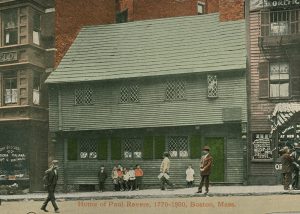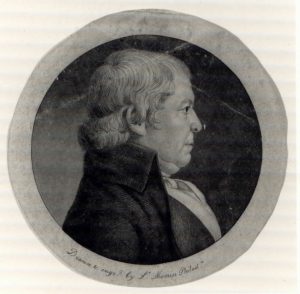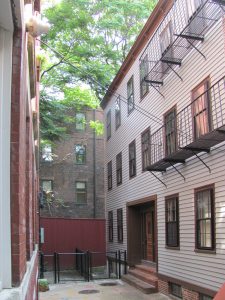
30 Jun 2017 Happy 4th of July! Paul Revere’s Revolutionary Effect on Historic Preservation
Though most famous for his Midnight Ride, Paul Revere and his home play an important part in Boston’s history and historic preservation efforts. The house was built in 1680 by wealthy North End merchant, Robert Howard, on a site occupied until the Great Fire of 1676 by the parsonage of the Second Church of Boston and its ministers including Increase and Cotton Mather. Born in Boston in 1734, Paul Revere purchased the home at 19 North St in 1770. From then until 1800, Revere, his wife, and children lived and worked in the North End. On April 18, 1775, after two lanterns were hung in the nearby Old North Church, Revere galloped on horseback from the North End to Lexington to alert Samuel Adams and John Hancock of the arrival of British troops. This is seen as the beginning of the American Revolution.
 After Revere sold the home in 1800, it became a sailor’s boarding house. By the end of the 1800s, the house had become an immigrant tenement and the ground floor was remodeled for commercial use. In 1902, Paul Revere’s great-grandson, John P. Reynolds Jr. purchased the home to prevent future demolition. In 1905, the Milton Record described the home as “a quaint dilapidated wooden house with queer chimneys and overhanging upper story. Looking into the hall through the open doorway, may be seen layers of variegated wallpapers. Thus the oldest building in Boston gradually sinking into utter ruin.” In 1906, Reynolds sold the Revere House to several trustees, who then in 1907, sold the house to the newly established Paul Revere Memorial Association, which officially became incorporated as a non-profit association dedicated to the preservation of the house and the memory of Paul Revere. In April 1908, the restored Paul Revere House opened to the public as one of the earliest historic house museums in the United States.
After Revere sold the home in 1800, it became a sailor’s boarding house. By the end of the 1800s, the house had become an immigrant tenement and the ground floor was remodeled for commercial use. In 1902, Paul Revere’s great-grandson, John P. Reynolds Jr. purchased the home to prevent future demolition. In 1905, the Milton Record described the home as “a quaint dilapidated wooden house with queer chimneys and overhanging upper story. Looking into the hall through the open doorway, may be seen layers of variegated wallpapers. Thus the oldest building in Boston gradually sinking into utter ruin.” In 1906, Reynolds sold the Revere House to several trustees, who then in 1907, sold the house to the newly established Paul Revere Memorial Association, which officially became incorporated as a non-profit association dedicated to the preservation of the house and the memory of Paul Revere. In April 1908, the restored Paul Revere House opened to the public as one of the earliest historic house museums in the United States.
About a decade ago, the Paul Revere Memorial Association also purchased 5-6 Lathrop Place to serve as an educational and visitors center. Very careful efforts were made to restore or replicate  key historical features including the cooking fireplaces, stairways, windows, cornice, and clapboards, and to preserve the structure’s early history. This important structure now combines historic features with modern amenities for visitors and is fully accessible, a difficult task to achieve in historic buildings. In 2017 the preservation efforts of the Paul Revere House have been awarded a Preservation Achievement Award from the Boston Preservation Alliance. In addition to this property, the Paul Revere Memorial Association also acquired the Pierce/Hichborn House, in 1970. The Pierce/ Hichborn House is a 1711 excellent example of early Georgian architecture and one of the oldest remaining brick structures in Boston.
key historical features including the cooking fireplaces, stairways, windows, cornice, and clapboards, and to preserve the structure’s early history. This important structure now combines historic features with modern amenities for visitors and is fully accessible, a difficult task to achieve in historic buildings. In 2017 the preservation efforts of the Paul Revere House have been awarded a Preservation Achievement Award from the Boston Preservation Alliance. In addition to this property, the Paul Revere Memorial Association also acquired the Pierce/Hichborn House, in 1970. The Pierce/ Hichborn House is a 1711 excellent example of early Georgian architecture and one of the oldest remaining brick structures in Boston.
The Paul Revere House and Historic Boston, Inc are connected in a few unique ways. The Paul Revere House and the 1718 Old Corner Bookstore (HBI’s flagship property) are among the earliest historic buildings remaining in downtown Boston and both are stops along the Freedom Trail. In addition, Henry Wadsworth Longfellow’s poem “Paul Revere’s Ride”, which immortalized that fateful night, was featured first in The Atlantic Monthly, a publication also first produced by the publishers Ticknor and Fields at the Old Corner Bookstore.
Photos courtesy of paulreverehouse.org



